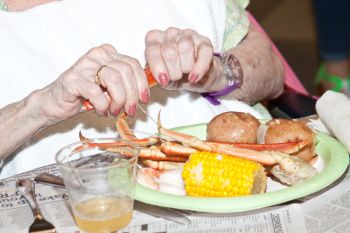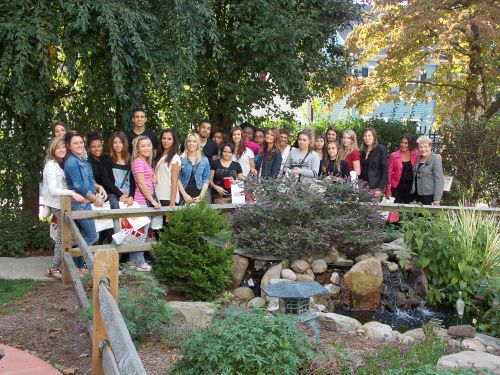Homeland’s Hummel collection
 In the 1920 and ‘30s, a Bavarian nun named Sister Maria Innocentia Hummel drew sketches capturing the innocence and charm of the children around her. As her sketches grew popular, German porcelain maker Franz Goebel began producing them in figurines – each piece subject to Sister Maria’s approval.
In the 1920 and ‘30s, a Bavarian nun named Sister Maria Innocentia Hummel drew sketches capturing the innocence and charm of the children around her. As her sketches grew popular, German porcelain maker Franz Goebel began producing them in figurines – each piece subject to Sister Maria’s approval.
But while her sketches were lighthearted, her days grew darker. Sister Maria endured Nazi persecution and the deprivations of World War II. A lack of heat and food contributed to her deteriorating health, but she refused to leave her convent community, and she died in 1946, age 37, from tuberculosis. Despite the hardships, her love of childhood joys – a game of ring around the rosy, a little girl on laundry day, a boy hiking through the woods – endured in the famous Hummel figurines.
The Hummel legacy lives on at Homeland Center, where residents and visitors enjoy a display of more than 150 Hummel figurines and plates donated by resident Lou Hepschmidt in memory of her husband, John Hepschmidt.
“Other places did not have the same ambience and décor that Homeland has, and the same treatment of the residents,” she says. “I am so pleased with the way they treat everybody here. I know I’m treated royally. I have often told people to be careful what you ask for, because you’re going to get it, whether you want it or not. That’s the way they are here. The Hummel collection fits right in.”
John Hepschmidt started collecting Hummels during Chamber of Commerce trips to Germany in the 1950s. Lou picked up the habit after they married in 1966 and, she admits, “kind of got carried away.” Her first purchase with her own money depicted a young mail clerk. She expanded the collection by buying pieces that reflected her interests and family life.
“Mostly, I bought figures that represented what I did,” she says. “Some might be knitting or doing cross-stitch, which I like to do.”
The collection grew so large that the Hepschmidts had two massive cabinets built for their dining and living rooms. After she chose to live at Homeland, Lou felt that the collection – with each piece hand-painted to exacting standards – belonged there, too.
The two cabinets were transported to Homeland, and there, Hepschmidt arranged the display as exactingly as any Hummel artisan, pairing plates with matching figurines. In the Homeland Center chapel, a small cabinet was installed for religious-themed figurines. At Christmastime, Hepschmidt arranges a Hummel nativity scene.
Hepschmidt knew that Homeland Center would respect the precious collection built piece by piece with her husband. Sometimes, she gives talks for residents to enjoy, sharing the fascinating history behind the porcelain.
“Everybody I talk to tells me they love them, and every time they look, they see a different one,” she says. “It’s a history lesson, along with the beauty of the pieces.”

 For a small group of Homeland Center residents, their twice-weekly knitting circle isn’t just a chance to chat as they create intricate patterns. These four ladies knit with a purpose – creating slippers for homeless women and children.
For a small group of Homeland Center residents, their twice-weekly knitting circle isn’t just a chance to chat as they create intricate patterns. These four ladies knit with a purpose – creating slippers for homeless women and children. It’s perhaps the most insidious of all diseases. Dementia doesn’t sicken the body. It steals the mind, slowly robbing an individual’s very essence, their personality. All that makes them who they are.
It’s perhaps the most insidious of all diseases. Dementia doesn’t sicken the body. It steals the mind, slowly robbing an individual’s very essence, their personality. All that makes them who they are. Debbie Haas, director of skilled-care admissions and the 21- bed Ellenberger Unit for those with dementia, advises family members to be aware of subtle changes in a loved one’s usual routines. Are bills going unpaid? Is their hygiene slipping? Are they wearing the same clothes? Not eating well? Forgetting to take their medicine?
Debbie Haas, director of skilled-care admissions and the 21- bed Ellenberger Unit for those with dementia, advises family members to be aware of subtle changes in a loved one’s usual routines. Are bills going unpaid? Is their hygiene slipping? Are they wearing the same clothes? Not eating well? Forgetting to take their medicine? She recommends resources like the Alzheimer’s Association and the dementia care book, entitled “The 36-hour Day.”
She recommends resources like the Alzheimer’s Association and the dementia care book, entitled “The 36-hour Day.” “Read the patient,” advises Haas. “As the day progresses, they get more confused. We call this sun-downing. As the day goes on, as they are more tired, it does change them. Gauge when your loved one is more awake and lucid. Don’t bring it up when they are frustrated, or you are frustrated. Bring up the conversation when everyone is clam.”
“Read the patient,” advises Haas. “As the day progresses, they get more confused. We call this sun-downing. As the day goes on, as they are more tired, it does change them. Gauge when your loved one is more awake and lucid. Don’t bring it up when they are frustrated, or you are frustrated. Bring up the conversation when everyone is clam.” Maybe you get scared after seeing an older loved one fall. Or your mom or dad is getting more than a little confused — not forgetting the keys but forgetting what they are for. Perhaps a former happy homemaker begins letting things go; the house is dirty, personal hygiene slips.
Maybe you get scared after seeing an older loved one fall. Or your mom or dad is getting more than a little confused — not forgetting the keys but forgetting what they are for. Perhaps a former happy homemaker begins letting things go; the house is dirty, personal hygiene slips. The first thing families considering any kind of residential care for their aging loved one need to know is that nobody has failed.
The first thing families considering any kind of residential care for their aging loved one need to know is that nobody has failed. Once a family has seen the signs of decline in an aging loved one and decided they can no longer live on their own, the next step is to convince the loved one that a change is needed. In this, it’s better not to go it alone.
Once a family has seen the signs of decline in an aging loved one and decided they can no longer live on their own, the next step is to convince the loved one that a change is needed. In this, it’s better not to go it alone. You’re almost there. With the help of your loved one’s doctor, you’ve convinced them that transiting to a personal care or nursing facility is the right move for their health, safety and welfare – not to mention maximizing their social life.
You’re almost there. With the help of your loved one’s doctor, you’ve convinced them that transiting to a personal care or nursing facility is the right move for their health, safety and welfare – not to mention maximizing their social life. The students and their teacher were from Lyon, a city in southeast France with which Governor Tom Corbett’s office has an economic and cultural exchange program. Working with the governor’s office, Harristown Development Corp. coordinated the trip. Harristown, which owns and operates the downtown Strawberry Square retail and office complex, promotes social and economic activity in the Capital.
The students and their teacher were from Lyon, a city in southeast France with which Governor Tom Corbett’s office has an economic and cultural exchange program. Working with the governor’s office, Harristown Development Corp. coordinated the trip. Harristown, which owns and operates the downtown Strawberry Square retail and office complex, promotes social and economic activity in the Capital. “We know that we’re not going to replace someone’s home, so we try to provide the next-best experience,” Ramper told the students, who also toured Homeland. “We want to provide our resident the experience of being in a great hotel.”
“We know that we’re not going to replace someone’s home, so we try to provide the next-best experience,” Ramper told the students, who also toured Homeland. “We want to provide our resident the experience of being in a great hotel.” In keeping with its dedication to serving the community, Homeland Center established Homeland Hospice to help patients in the end stages of life and provide emotional support for their families.
In keeping with its dedication to serving the community, Homeland Center established Homeland Hospice to help patients in the end stages of life and provide emotional support for their families.
